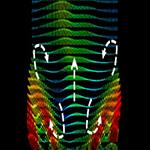

We assess some fundamental assumptions in the theory of turbulent combustion by recording high-framing rate movies that show how turbulent eddies interact with flamefronts. Our movies visualize how eddies increase area of flamefronts (wrinkling) and how eddies increase thicknesses of reaction zones (distributed reactions). Eddies are seen to break holes in reaction layers, promoting distributed mixing and changing flame structure. Our diagnostics include kilohertz Planar Laser Induced Fluorescence (PLIF of formaldehyde) to image flamefronts and kilohertz Particle Image Velocity (PIV) to track the turbulent eddies. Funded by NSF and AFOSR.

Two model gas turbine combustors are studied; one has a single GE TAPS Jet-A liquid fuel injector while the other has a single Siemens gaseous fuel injector. Both undergo a "growl" acoustic-combustion instability which is an important problem. "Growl" was shown to be due to a Helmholtz resonance forced by the flame and we simulated it with a harmonic oscillator differential equation and the measured flame forcing function and acoustic damping. An LES computer simulation is done at Stanford. The Michigan experiment employs PLIF and PIV laser diagnostics to image flames, velocity and phase differences needed for models. Flame index was measured for the first time; it indicates what fraction of flamelets are premixed versus non-premixed and is needed for models. Funded by GE-USA and NSF.

A control-oriented model of hypersonic vehicles was developed for AFRL for an X-43 aerospace plane geometry. It predicts operability limits (ram-scram transition, flameout, unstart margin) for a trimmed vehicle along an ascent trajectory. Optimization of geometry (MDO) and the trajectory employs surrogate methods. Operability limits require we include real gas effects (gas dissociation, finite rate chemistry) to simulate engine flameout and combustion inefficiencies. See: Torrez, S. J. Prop. Power 27, 371, 2011. Funded by AFRL.

In our Mach 2.75 supersonic wind tunnel we interact oblique shock waves with the bottom wall and sidewall boundary layers to study the complex three-dimensional separation topology. Stereo-PIV velocity measurements were compared to CFD simulations. Topology includes saddle points, nodes and focus points - identified from streamlines and skin friction lines. Lateral velocities explain how adjacent separation zones interact. Funded by AFRL.

A hydrogen fuel jet is injected perpendicular to a heated 1400 K supersonic air flow to understand how to prevent flameout and improve combustion efficiency. Our PLIF and PIV laser imaging results tell us how the flame is stabilized and where the fuel is burned. Funding: DOD.